Marantz M-CR510 Owners Manual
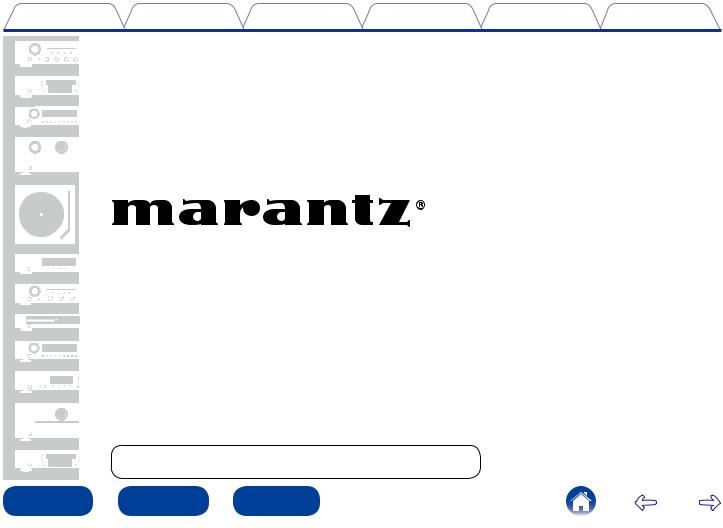
Contents |
Connections |
Playback |
Settings |
Tips |
Appendix |
You can print more than one page of a PDF onto a single sheet of paper.
|
|
|
|
|
|
|
|
|
|
Front panel |
|
|
Rear panel |
|
|
Remote |
|
|
Index |
|
|
|
|
|
|
|
|
|
|
|
|
|
|
|
|
|
|
|
|
Network Receiver
M-CR510
Owner’s Manual
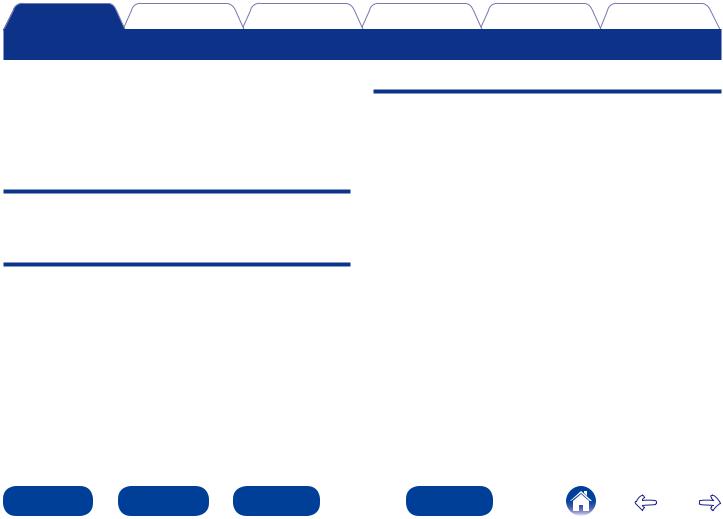
Contents |
Connections |
Playback |
Settings |
Tips |
Appendix |
Contents
Accessories························································································ 5 Inserting the batteries······································································· 6 Operating range of the remote control unit······································ 6
Features······························································································ 7 Multiple music formats are supported, all in a compact
form factor························································································ 7 Easy operation·················································································· 7
Part names and functions
Front panel························································································· 8 Rear panel························································································ 10 Remote control unit······································································ 12
Connections
Speaker connection······································································· 16 Connecting the speaker cables······················································· 16 Connection the subwoofer····························································· 17 Speaker connection········································································ 17
Connecting an analog device····················································· 18
Connecting a digital device························································· 18
Connecting an iPod or USB memory device
to the USB port··············································································· 19 Connecting to a home network (LAN)····································· 21 Wired LAN······················································································ 21 Wireless LAN·················································································· 22
Connecting the power cord························································ 23
Playback
Basic operation··············································································· 25 Turning the power on····································································· 25 Selecting the input source······························································ 25 Adjusting the master volume·························································· 26 Turning off the sound temporarily··················································· 26
Listening to Internet Radio························································· 27 Listening to Internet Radio····························································· 28 Playing the last played Internet Radio station································· 29 Using vTuner to add Internet Radio stations to favorites··············· 29
Playing back files stored on a PC and NAS···························· 30 Applying media sharing settings····················································· 31 Playing back files stored on a PC and NAS····································· 32
Listening to Pandora®·································································· 34 Listening to Pandora®······································································ 35 Creating a new station···································································· 35 Listening to an existing station······················································· 36 Play random songs from your stations (Quick Mix)························ 36 Giving Feedback and Managing Stations········································ 37 Sign Out·························································································· 37
Listening to SiriusXM Internet Radio······································ 38
Listening to SiriusXM Internet Radio·············································· 39 Sign Out·························································································· 39
Listening to Spotify······································································· 40 Listening to Spotify········································································· 40
|
|
|
|
|
|
|
|
2 |
|
|
Front panel |
|
|
Rear panel |
|
|
Remote |
|
Index |
|
|
|
|
|
|
|
|
|
|
|
|
|
|
|
|
|
|
|
|
|
|
|
|

Contents |
Connections |
Playback |
Settings |
Tips |
Appendix |
|
|
|
|
|
|||
Favorite function············································································ 43 |
Settings |
|
|
|||
Registering stations or files to the favorites list····························· 44 |
|
|
|
|||
Menu map························································································ 65 |
||||||
Calling stations or files from the favorites list································· 44 |
||||||
To switch between registered stations and files |
|
Menu operation·············································································· 67 |
||||
during playback··············································································· 44 |
Inputting characters······································································ 68 |
|||||
Deleting stations or files from the favorite list································ 44 |
Using the number buttons······························································ 68 |
|||||
Playing iPod····················································································· 45 |
Using the cursor buttons································································ 68 |
|||||
Listening to music on an iPod························································· 46 |
General······························································································ 69 |
|||||
Setting operation mode (Remote iPod Mode)································ 47 |
Alarm······························································································ 69 |
|||||
Charging the iPod/iPhone······························································· 48 |
Clock······························································································· 70 |
|||||
Playing a USB memory device··················································· 49 |
Speaker Response·········································································· 70 |
|||||
Playing files stored on USB memory devices································· 50 |
Language························································································ 71 |
|||||
Listening to ANALOG IN······························································ 51 |
Auto-Standby·················································································· 71 |
|||||
Listening to DIGITAL IN······························································· 51 |
Firmware························································································· 71 |
|||||
AirPlay function·············································································· 52 |
Network···························································································· 74 |
|||||
Streaming music stored in iPhone, iPod touch, |
|
Network Information······································································· 74 |
||||
or iPad directly to the unit······························································· 52 |
Network Control············································································· 74 |
|||||
Playing iTunes music with this unit················································ 53 |
Friendly Name················································································· 74 |
|||||
Selecting multiple speakers (devices)············································· 53 |
Settings··························································································· 75 |
|||||
Perform iTunes playback operations with the remote control unit
of this unit······················································································· 54
Remote play function···································································· 55 Settings required for each device··················································· 56
Web control function···································································· 57 Controlling the unit from a web control·········································· 57
Other functions··············································································· 62 Adjusting the tone·········································································· 63 Sleep timer function······································································· 64 Checking the current time······························································ 64 Switching the display’s brightness················································· 64
|
|
|
|
|
|
|
|
3 |
|
|
Front panel |
|
|
Rear panel |
|
|
Remote |
|
Index |
|
|
|
|
|
|
|
|
|
|
|
|
|
|
|
|
|
|
|
|
|
|
|
|
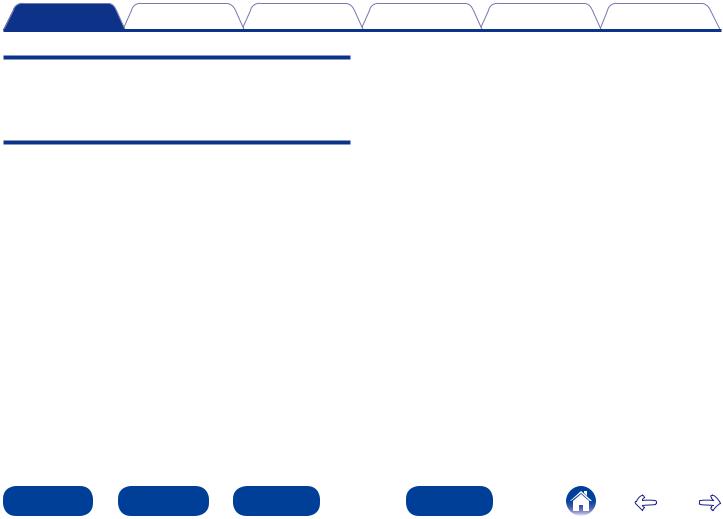
Contents |
Connections |
Playback |
Settings |
Tips |
Appendix |
Tips
Contents··························································································· 78
Tips································································································· 79
Troubleshooting·············································································· 80
Resetting factory settings··························································· 89
Appendix
Playing back USB memory devices·············································· 90
Playing back Internet Radio···························································· 91
Playing back files stored on PC or NAS········································ 92
Last function memory····································································· 92
Explanation of terms········································································ 93
Trademark information···································································· 97
Specifications···················································································· 98
Index································································································· 101
License····························································································· 103
|
|
|
|
|
|
|
|
4 |
|
|
Front panel |
|
|
Rear panel |
|
|
Remote |
|
Index |
|
|
|
|
|
|
|
|
|
|
|
|
|
|
|
|
|
|
|
|
|
|
|
|
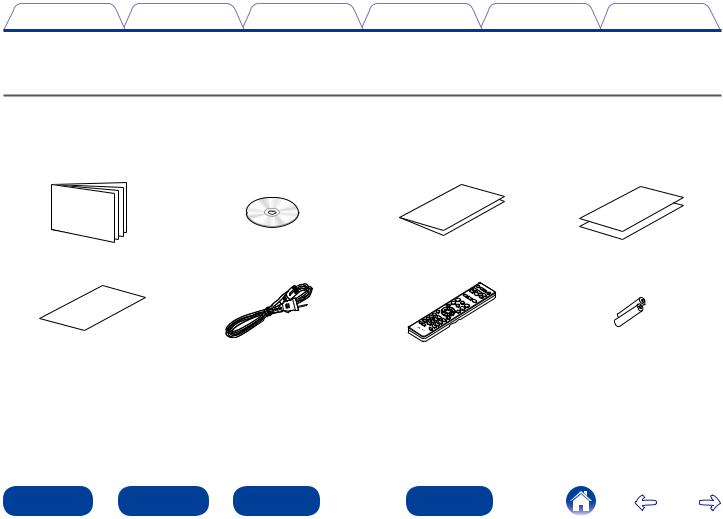
Contents |
Connections |
Playback |
Settings |
Tips |
Appendix |
Thank you for purchasing this Marantz product. To ensure proper operation, please read this owner’s manual carefully before using the product. After reading this manual, be sure to keep it for future reference.
Accessories
Check that the following parts are supplied with the product.
q Quick Setup Guide |
w CD-ROM (Owner’s Manual) |
e Safety Instructions |
r Warranty |
|
(for USA) |
||||
|
|
|
||
|
|
|
(for CANADA) |
t Notes on radio |
y Power cord |
u Remote control unit (RC010CR) i R03/AAA batteries |
|
|
|
|
|
|
|
|
|
5 |
|
|
Front panel |
|
|
Rear panel |
|
|
Remote |
|
Index |
|
|
|
|
|
|
|
|
|
|
|
|
|
|
|
|
|
|
|
|
|
|
|
|
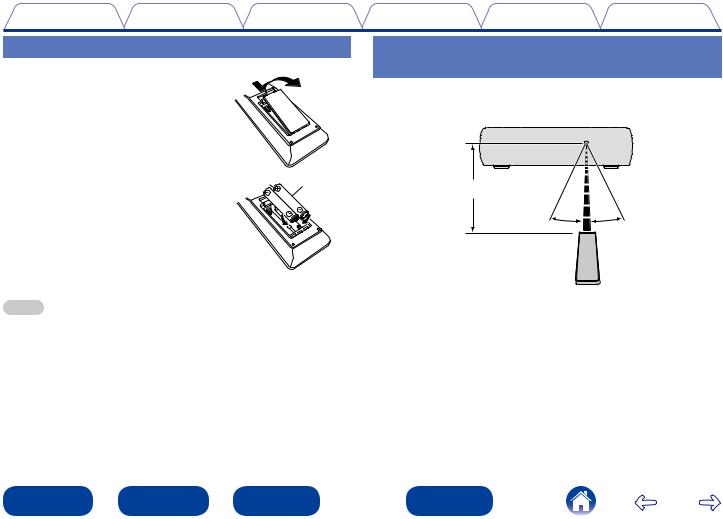
Contents |
Connections |
Playback |
Settings |
Tips |
Appendix |
Inserting the batteries
qRemove the rear lid in the direction of the arrow and remove it.
Operating range of the remote control unit
Point the remote control unit at the remote sensor when operating it.
w Load the two batteries properly as |
R03/AAA |
Approx. 23 ft/7 m |
|
indicated by the q and w marks in the |
|
|
|
|
|
|
|
battery compartment. |
|
30° |
30° |
e Put the rear cover back on.
NOTE
•When inserting the batteries, be sure to do so in the proper direction, following the q and w marks in the battery compartment.
•To prevent damage or leakage of battery fluid:
•Do not use a new battery together with an old one.
•Do not use two different types of batteries.
•Remove the batteries from the remote control unit if it will not be in use for long periods.
•If the battery fluid should leak, carefully wipe the fluid off the inside of the battery compartment and insert new batteries.
|
|
|
|
|
|
|
|
6 |
|
|
Front panel |
|
|
Rear panel |
|
|
Remote |
|
Index |
|
|
|
|
|
|
|
|
|
|
|
|
|
|
|
|
|
|
|
|
|
|
|
|
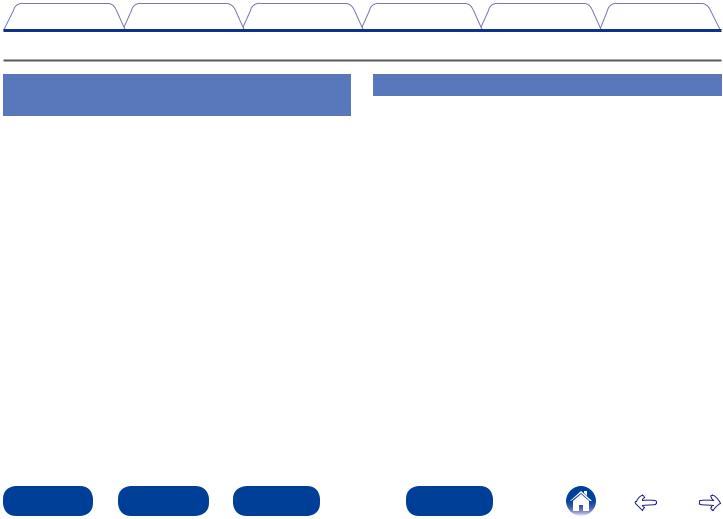
Contents |
Connections |
Playback |
Settings |
Tips |
Appendix |
Features
Multiple music formats are supported, all in a compact form factor
•Supports Internet Radio and music streaming Supports AirPlay® (vpage 52)
You can enjoy a wide variety of content, including listening to Internet Radio, playing audio files stored on your PC.
This unit also supports Apple AirPlay which lets you stream your music library from an iPhone®, iPad®, iPod touch® or iTunes®.
•DLNA ver. 1.5 support for audio networks
•Supports online music, including Pandora®, SiriusXM, Spotify
•Support for High Quality Audio playback WAV/FLAC/ALAC (Apple Lossless Audio Codec)
•Support for Gapless playback
Playback with no gap between music files (for WAV/FLAC only)
•Wi-Fi network capability with built-in diversity antenna, and is certified under WMM (Wi-Fi Multi Media) for efficient wireless connectivity
Easy operation
•Easy wireless connection is possible by pressing the Wi-Fi CONNECT button (WPS and Wi-Fi Sharing)
See the separate “Quick Setup Guide”.
•iPod auto detect charges your device even after the unit switches to standby mode
•Compatible with “Marantz Remote App” for performing basic operations of the unit with an iPad, iPhone or Androidzsmartphone
“Marantz Remote App” is application software that allows you to perform basic operations with an iPad, iPhone, Android smartphone or Android tablet such as turning the unit ON/OFF, controlling the volume, and switching the source.
zz Download the appropriate “Marantz Remote App” for iOS and Android devices. This unit needs to be connected to your LAN and the iPad, iPhone, Android smartphone, Android tablet or other device needs to be connected to the same network by Wi-Fi (wireless LAN).
•3 Line OLED (Organic Light Emitting Diode) display
•Auto Standby mode for energy savings
|
|
|
|
|
|
|
|
7 |
|
|
Front panel |
|
|
Rear panel |
|
|
Remote |
|
Index |
|
|
|
|
|
|
|
|
|
|
|
|
|
|
|
|
|
|
|
|
|
|
|
|
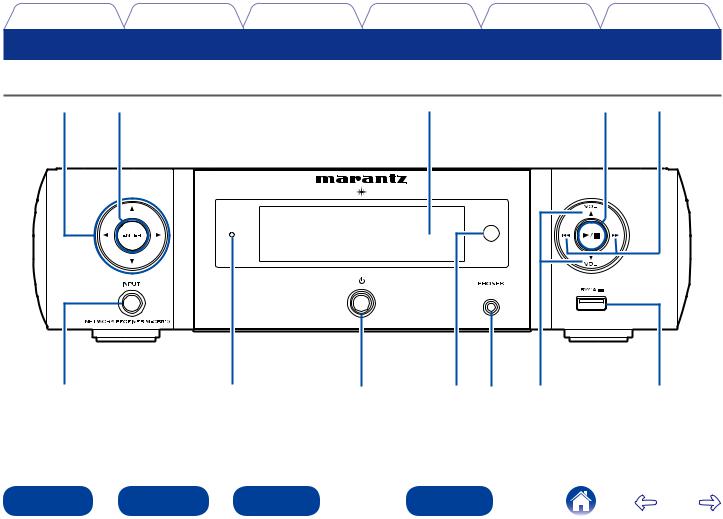
Contents |
Connections |
Playback |
Settings |
Tips |
Appendix |
Part names and functions
Front panel
Q2 Q1 |
Q0 |
o |
i |
q |
w |
e |
r |
t |
y |
u |
|
|
|
|
|
|
|
|
8 |
|
|
Front panel |
|
|
Rear panel |
|
|
Remote |
|
Index |
|
|
|
|
|
|
|
|
|
|
|
|
|
|
|
|
|
|
|
|
|
|
|
|
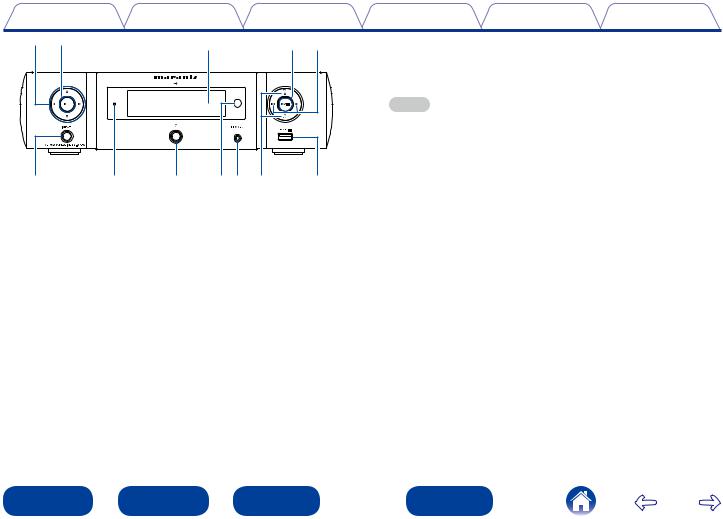
Contents |
Connections |
Playback |
Settings |
Tips |
Appendix |
Q2Q1 |
|
|
Q0 |
o i |
q |
w |
e |
r t y |
u |
qINPUT button
Selects the input source.
wStandby indicator
The standby indicator changes as shown below according to the status of the unit.
•Power on : Off
•Standby : Off
•When “Network Control” is set to “On” : Red (vpage 74)
•iPod charge standby : Red (vpage 48)
•Alarm standby : Orange (vpage 69)
•Display off : Green (vpage 64)
ePower operation button (X)
Turns power to this unit on and off (standby).
rRemote control sensor
This receives signals from the remote control unit (vpage 6).
tHeadphones jack (PHONES)
Used to connect headphones.
When the headphones are plugged into this jack, audio will no longer be output from the connected speakers.
NOTE
•To prevent hearing loss, do not raise the volume level excessively when using headphones.
yVolume up/down button (VOLUME df)
Adjusts the audio volume.
uUSB port (Front)
Used to connect iPod or USB memory devices (vpage 19). iReverse-skip/Forward-skip buttons (8, 9)
oPlay/Pause button (1/3)
Q0Display
Various information is displayed here.
Q1ENTER button
This determines the selection.
Q22Cursor button (uio p)
These select items.
|
|
|
|
|
|
|
|
9 |
|
|
Front panel |
|
|
Rear panel |
|
|
Remote |
|
Index |
|
|
|
|
|
|
|
|
|
|
|
|
|
|
|
|
|
|
|
|
|
|
|
|
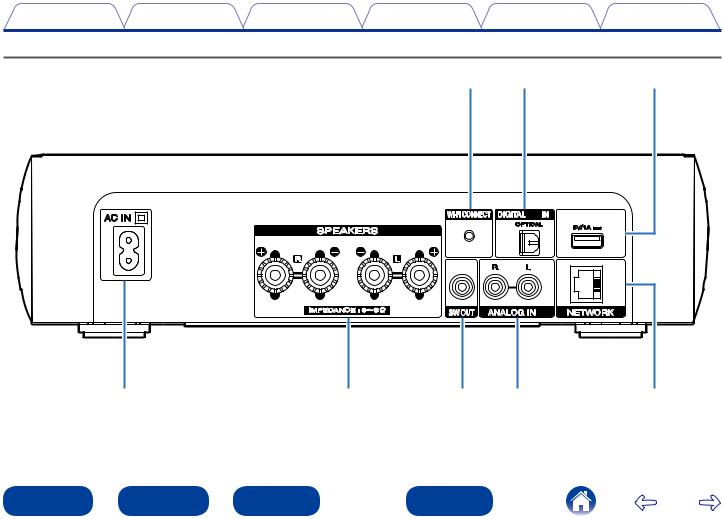
Contents |
Connections |
Playback |
Settings |
Tips |
Appendix |
Rear panel
i |
u |
y |
q |
w |
e |
r |
t |
|
|
|
|
|
|
|
|
10 |
|
|
Front panel |
|
|
Rear panel |
|
|
Remote |
|
Index |
|
|
|
|
|
|
|
|
|
|
|
|
|
|
|
|
|
|
|
|
|
|
|
|
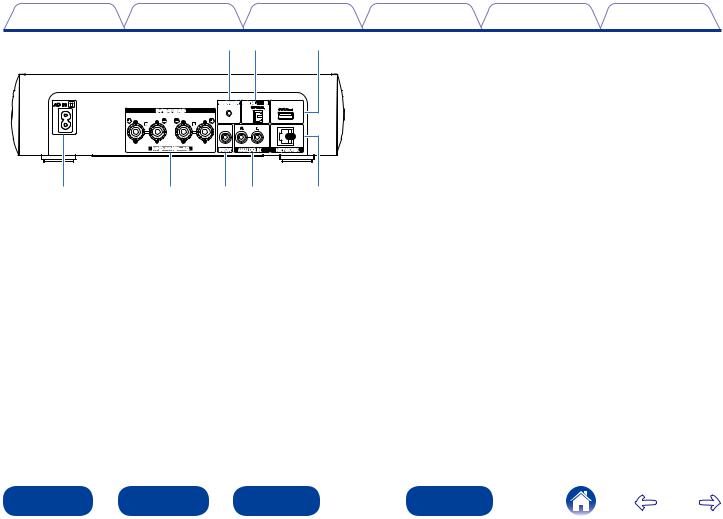
Contents |
Connections |
Playback |
Settings |
Tips |
Appendix |
|
|
|
i u |
y |
yUSB port (Rear) |
|
|
|
|
|
|
Used to connect iPod or USB memory devices (vpage 19). |
||
|
|
|
|
uDIGITAL IN connector |
|
|
|
|
|
|
Used to connect devices equipped with digital audio connector |
||
|
|
|
|
(vpage 18). |
|
|
|
|
|
|
iWi-Fi CONNECT button |
|
|
|
|
|
|
Used to connect to the wireless LAN. |
|
|
|
|
|
|
(See the separate “Quick Setup Guide”.) |
|
|
q |
w |
e r |
t |
|
|
|
qAC inlet (AC IN) |
|
|
|
|
|
|
Used to connect the power cord (vpage 23). |
|
|
|
|
||
wSpeaker terminals (SPEAKERS) |
|
|
|
|
|
|
Used to connect speakers (vpage 16, 17). |
|
|
|
|
||
eSW OUT connector |
|
|
|
|
|
|
Used to connect a subwoofer with a built-in amplifier |
|
|
|
|||
(vpage 17). |
|
|
|
|
|
|
rANALOG IN connectors |
|
|
|
|
|
|
Used to connect devices |
equipped |
with analog |
audio connectors |
|
|
|
(vpage 18). |
|
|
|
|
|
|
tNETWORK connector
Used to connect this unit to the network (vpage 21).
|
|
|
|
|
|
|
|
11 |
|
|
Front panel |
|
|
Rear panel |
|
|
Remote |
|
Index |
|
|
|
|
|
|
|
|
|
|
|
|
|
|
|
|
|
|
|
|
|
|
|
|
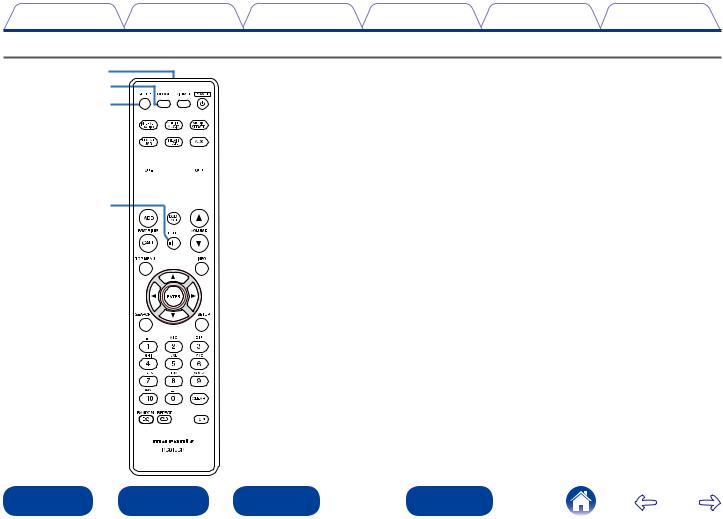
Contents |
Connections |
Playback |
Settings |
Tips |
Appendix |
Remote control unit
q w e
r
t


 y
y
qRemote control signal transmitter
This transmits signals from the remote control unit (vpage 6).
wCLOCK button
The current time appear on the unit (vpage 70).
eSLEEP button
This sets the sleep timer (vpage 64).
rInput source select buttons
These select the input source (vpage 25).
tSystem buttons
These perform playback related operations (vpage 28, 32, 34, 38, 40, 47, 50).
•Previous / Next buttons (8, 9)
•Play/pause button (1/3)
Channel buttons (CH +, –)
These operate the Favorite function (vpage 43).
yMUTE button (
 )
)
This mutes the output audio (vpage 26).
|
|
|
|
|
|
|
|
12 |
|
|
Front panel |
|
|
Rear panel |
|
|
Remote |
|
Index |
|
|
|
|
|
|
|
|
|
|
|
|
|
|
|
|
|
|
|
|
|
|
|
|
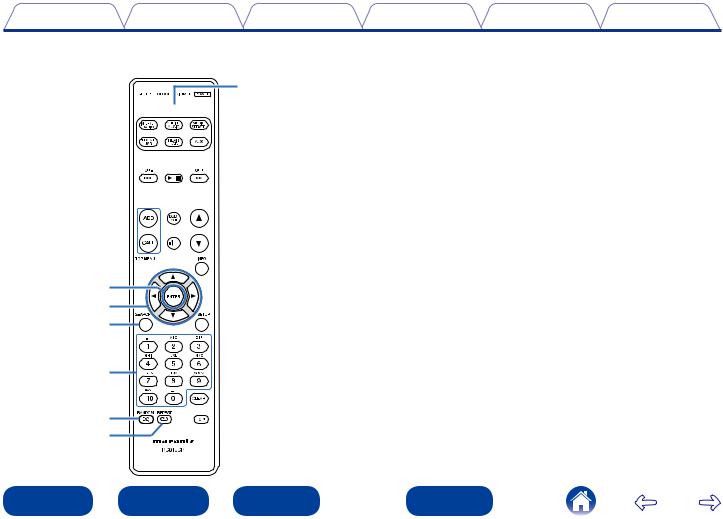
Contents |
Connections |
Playback |
Settings |
Tips |
Appendix |
Q5




 Q6
Q6
u









i
 o
o
Q0
Q1
Q2
Q3
Q4
uFAVORITES ADD / CALL buttons
•To add radio stations or files to the favorite list, press ADD.
•To call up a radio station or file registered in the favorite list, press CALL (vpage 43).
iTOP MENU button
To back to the top of the menu (vpage 67).
oENTER button
This determines the selection (vpage 67).
Q0Cursor buttons (uio p)
These select items (vpage 67).
Q1SEARCH button
This displays the search menu (vpage 28, 50).
Q2Number buttons (0 – 9, +10)
These enter letters or numbers into the unit (vpage 68).
Q3RANDOM button
Switches the random playback.
Q4REPEAT button
Switches the repeat playback (vpage 32, 40, 47, 50).
Q5DIMMER button
Adjust the display brightness of this unit (vpage 64).
Q6POWER button (X)
This turns the power on/standby (vpage 25).
|
|
|
|
|
|
|
|
13 |
|
|
Front panel |
|
|
Rear panel |
|
|
Remote |
|
Index |
|
|
|
|
|
|
|
|
|
|
|
|
|
|
|
|
|
|
|
|
|
|
|
|
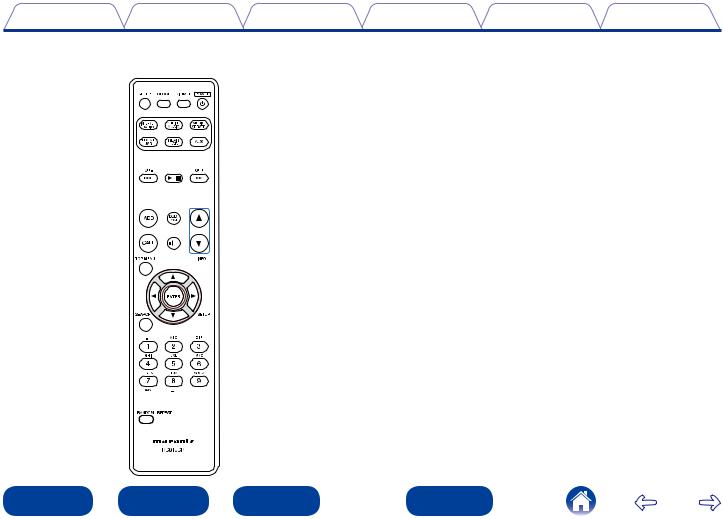
Contents |
Connections |
Playback |
Settings |
Tips |
Appendix |
 Q7
Q7 








 Q8
Q8
 Q9
Q9
 W0
W0


 W1
W1 

 W2
W2
Q7DBB/TONE button
Adjusting the tone (vpage 63).
Q8VOLUME buttons (df)
These adjust the volume level (vpage 26).
Q9Information button (INFO)
This switches display items such as the album name and title name in the playback screen (vpage 32, 34, 39, 47, 49).
W0SETUP button
This displays the setup menu on the display (vpage 67).
W1CLEAR button
This cancels the settings (vpage 44, 68).
W2MODE button
Switching the operation mode (vpage 47).
|
|
|
|
|
|
|
|
14 |
|
|
Front panel |
|
|
Rear panel |
|
|
Remote |
|
Index |
|
|
|
|
|
|
|
|
|
|
|
|
|
|
|
|
|
|
|
|
|
|
|
|
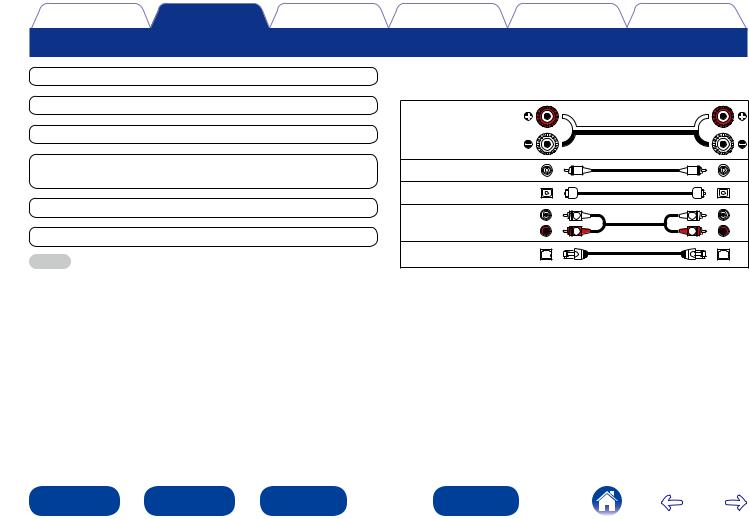
Contents |
Connections |
Playback |
Settings |
Tips |
Appendix |
Connections
Speaker connection (vpage 16)
Connecting an analog device (vpage 18)
Connecting a digital device (vpage 18)
Connecting an iPod or USB memory device to the USB port (vpage 19)
Connecting to a home network (LAN) (vpage 21)
Connecting the power cord (vpage 23)
NOTE
22Cables used for connections
Provide necessary cables according to the devices you want to connect.
Speaker cable
Subwoofer cable
Optical cable
Audio cable |
L |
L |
|
R |
R |
||
|
LAN cable
•Do not plug in the power cord until all connections have been completed.
•Do not bundle power cords together with connection cables. Doing so can result in noise.
|
|
|
|
|
|
|
|
15 |
|
|
Front panel |
|
|
Rear panel |
|
|
Remote |
|
Index |
|
|
|
|
|
|
|
|
|
|
|
|
|
|
|
|
|
|
|
|
|
|
|
|
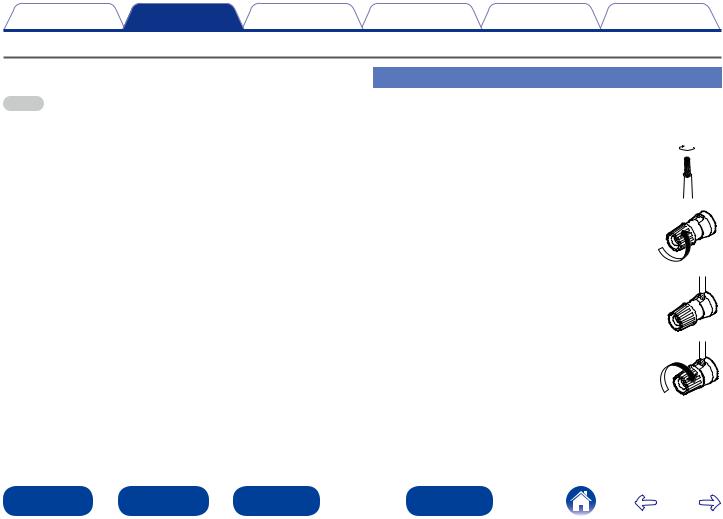
Contents |
Connections |
Playback |
Settings |
Tips |
Appendix |
Speaker connection
Here we connect the speakers in the room to this unit.
This section explains how to connect them using typical examples.
NOTE
•Disconnect this unit’s power plug from the power outlet before connecting the speakers. Also, turn off the subwoofer.
•Connect so that the speaker cable core wires do not protrude from the speaker terminal. The protection circuit may be activated if the core wires touch the rear panel or if the + and – sides touch each other (vpage 95 “Protection circuit”).
•Never touch the speaker terminals while the power cord is connected. Doing so could result in electric shock.
•Use speakers with an impedance of 6 – 8 Ω/ohms. The protection circuit may be activated if speakers with an impedance other than specified are used.
Connecting the speaker cables
Carefully check the left (L) and right (R) channels and + (red) and – (black) polarities on the speakers being connected to this unit, and be sure to connect the channels and polarities correctly.
1 Peel off about 3/8 inch (10 mm) of sheathing from the tip of the speaker cable, then either twist the core wire tightly or terminate it.
2 Turnthespeakerterminalcounterclockwise to loosen it.
3 |
Insert the speaker cable’s core wire to the |
hilt into the speaker terminal. |
4 Turn the speaker terminal clockwise to tighten it.
|
|
|
|
|
|
|
|
16 |
|
|
Front panel |
|
|
Rear panel |
|
|
Remote |
|
Index |
|
|
|
|
|
|
|
|
|
|
|
|
|
|
|
|
|
|
|
|
|
|
|
|
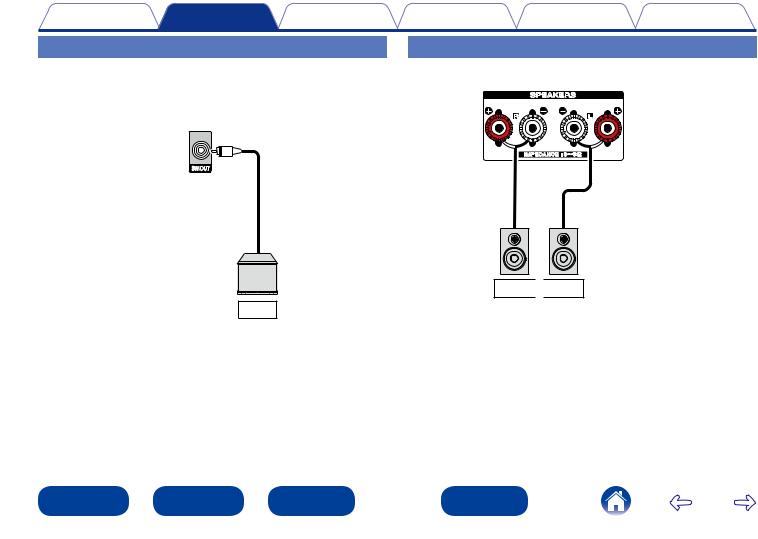
Contents |
Connections |
Playback |
Settings |
Tips |
Appendix |
Connection the subwoofer |
|
Speaker connection |
|
||
Use a subwoofer cable to connect the subwoofer.
R 
 L
L
SW
|
|
|
|
|
|
|
|
17 |
|
|
Front panel |
|
|
Rear panel |
|
|
Remote |
|
Index |
|
|
|
|
|
|
|
|
|
|
|
|
|
|
|
|
|
|
|
|
|
|
|
|

Contents Connections Playback Settings Tips Appendix
Connecting an analog device |
Connecting a digital device |
Analog |
Digital |
device |
device |
AUDIO |
AUDIO |
AUDIO |
OPTICAL |
OUT |
OUT |
R L |
|
R L |
|
R 
 L
L
|
|
|
|
|
|
|
|
|
|
|
|
|
|
|
|
|
|
|
|
|
|
|
|
|
|
|
|
|
|
|
|
|
|
|
|
|
|
|
|
|
|
|
|
|
|
|
|
|
|
|
|
|
|
|
|
|
|
|
|
|
|
|
|
|
|
|
|
|
|
|
|
|
|
|
|
|
|
|
|
|
|
|
|
|
|
|
|
|
|
|
|
|
|
|
|
|
|
|
|
|
|
|
|
|
|
|
|
|
|
|
|
|
|
|
|
|
|
|
|
|
|
|
|
|
|
|
|
|
|
|
|
|
|
|
|
|
|
|
|
|
|
|
|
|
|
|
|
|
|
|
|
|
|
|
|
|
|
|
|
|
|
|
|
|
|
|
|
|
|
|
|
|
|
|
|
|
|
|
|
|
|
|
|
|
|
|
|
|
|
|
|
|
|
|
|
|
|
|
|
|
|
|
|
|
|
|
|
|
|
|
|
|
|
|
|
|
|
|
|
|
|
|
|
|
|
|
|
|
|
|
|
|
|
|
|
|
|
|
|
|
|
|
|
|
|
|
|
|
|
|
|
|
|
|
|
|
|
|
|
|
|
|
|
|
|
|
|
|
|
|
|
|
|
|
|
|
|
|
|
|
|
|
|
|
|
|
|
|
|
|
|
|
|
|
|
|
|
|
|
|
|
|
|
|
|
|
|
|
|
|
|
|
|
|
|
|
|
|
|
|
|
|
|
|
|
|
|
|
|
|
|
|
|
|
|
|
|
|
|
|
|
|
|
|
|
|
|
|
|
|
|
|
|
|
|
|
|
|
|
|
|
|
|
|
|
|
|
|
|
|
|
|
|
|
|
|
|
|
|
|
|
|
|
|
|
|
|
|
|
|
|
|
|
|
|
|
|
|
|
|
|
|
|
|
|
|
|
|
|
|
|
|
|
|
|
|
|
|
|
|
|
|
|
|
|
|
|
|
|
|
|
|
|
|
|
|
|
|
|
|
|
|
|
|
|
|
|
|
|
|
|
|
|
|
|
|
|
|
|
|
|
|
|
|
|
|
|
|
|
|
|
|
|
|
|
|
|
|
|
|
|
|
|
|
|
|
|
|
|
|
|
|
|
|
|
|
|
|
|
|
|
|
|
|
|
|
|
|
|
|
|
|
|
|
|
|
|
|
|
|
|
|
|
|
|
|
|
|
|
|
|
|
|
|
|
|
|
|
|
|
|
|
|
|
|
|
|
|
|
|
|
|
|
|
|
|
|
|
|
|
|
|
|
|
|
|
|
|
|
|
|
|
|
|
|
|
|
|
|
|
|
|
|
|
|
|
|
|
|
|
|
|
|
|
|
|
|
|
|
|
|
|
|
|
|
|
|
|
|
|
|
|
|
|
|
|
|
|
|
|
|
|
|
|
|
|
|
|
|
|
|
|
|
|
|
|
|
|
|
|
|
|
|
|
|
|
|
|
|
|
|
|
|
|
|
|
|
|
|
|
|
|
|
|
|
|
|
|
|
|
|
|
|
|
|
|
|
|
|
|
|
|
|
|
|
|
|
|
|
|
|
|
|
|
|
|
|
|
|
|
|
18 |
|
|
|
|
|
|
|
|
|
|
|
|
|
|
|
|
|
|
|
|
|
|
|
|
|
|
|
|
|
|
|
|
|||||
|
|
|
|
|
|
|
|
|
|
|
|
|
|
|
|
|
|
|
|
|
|
|
|
|
|
|
|
|
|
|
|
|
|
|
|
|
|
|
|
|
|
|
|
|
|
|
|
|
|
|
|
|
|
|
|
|
|
|
|
|
|
|
|
|
|
|
|
||||||
Front panel |
|
|
|
|
|
Rear panel |
|
|
|
|
|
Remote |
|
|
|
|
|
|
|
|
|
Index |
|
|
|
|
|
|
|
|
|
|
|
|
|
|
|
|
|
|
|
|
|
|
|
|
|
||||||||||||||||||||||||||
|
|
|
|
|
|
|
|
|
|
|
|
|
|
|
|
|
|
|
|
|
|
|
|
|
|
|
|
|
|
|
|
|
|
|
|
|
|
|
|
|
|
|
|
|
|
|
|
|
|
|
|
|
|
|
|
|
|
|
|
|
|
|
|
|
|
|
|
|
|
|
|
|
|
|
|
|
|
|
|
|
|
|
|
|
|
|
|
|
|
|
|
|
|
|
|
|
|
|
|
|
|
|
|
|
|
|
|
|
|
|
|
|
|
|
|
|
|
|
|
|
|
|
|
|
|
|
|
|
|
|
|
|
|
|
|
|
|
|
|
|
|
|
|
|
|
|
|
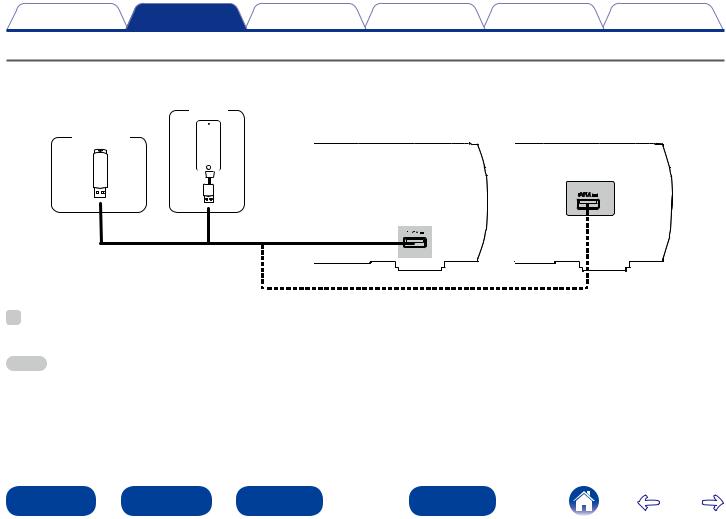
Contents |
Connections |
Playback |
Settings |
Tips |
Appendix |
Connecting an iPod or USB memory device to the USB port
To connect an iPod to this unit, use the USB adapter cable that was supplied with the iPod.
For operating instructions see “Playing iPod” (vpage 45) or “Playing a USB memory device” (vpage 49).
USB |
iPod |
|
memory |
Front |
Rear |
device |
||
|
or |
|
%
•Marantz does not guarantee that all USB memory devices will operate or receive power. When using a portable USB hard disk drive (HDD) which came with an AC adapter, use that device’s supplied AC adapter.
NOTE
•USB memory devices will not work via a USB hub.
•It is not possible to use this unit by connecting the unit’s USB port to a PC via a USB cable.
•Do not use an extension cable when connecting a USB memory device. This may cause radio interference with other devices.
|
|
|
|
|
|
|
|
19 |
|
|
Front panel |
|
|
Rear panel |
|
|
Remote |
|
Index |
|
|
|
|
|
|
|
|
|
|
|
|
|
|
|
|
|
|
|
|
|
|
|
|
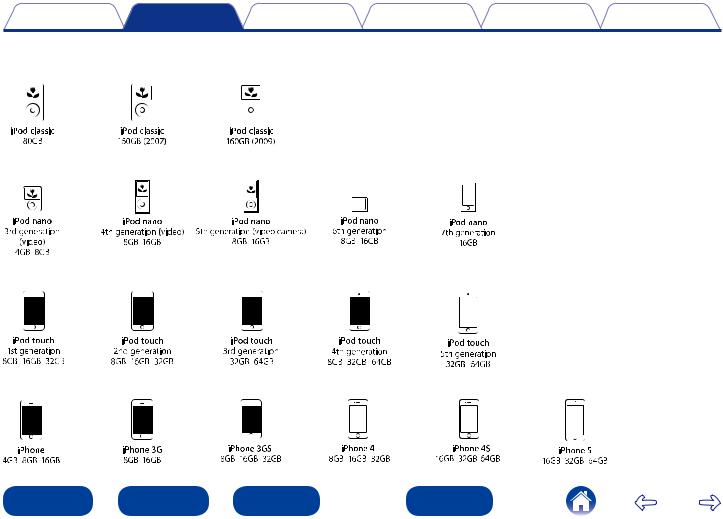
Contents |
Connections |
Playback |
Settings |
Tips |
Appendix |
22Supported iPod / iPhone models
•iPod classic
•iPod nano
•iPod touch
•iPhone
|
|
|
|
|
|
|
|
20 |
|
|
Front panel |
|
|
Rear panel |
|
|
Remote |
|
Index |
|
|
|
|
|
|
|
|
|
|
|
|
|
|
|
|
|
|
|
|
|
|
|
|
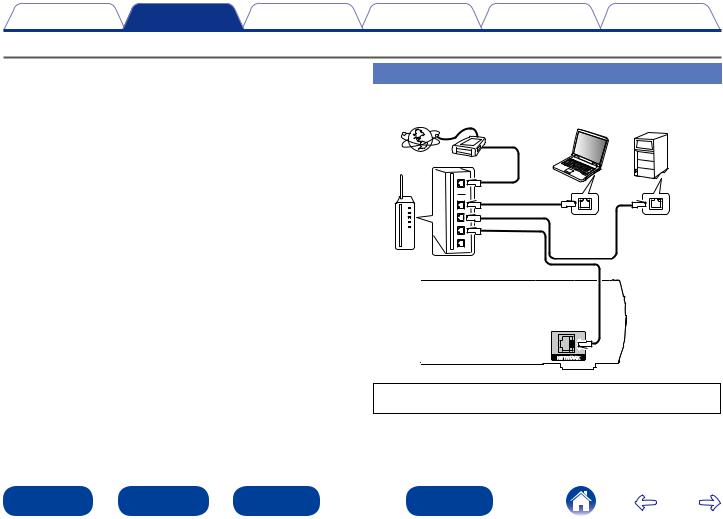
Contents |
Connections |
Playback |
Settings |
Tips |
Appendix |
Connecting to a home network (LAN)
You can connect this unit to your home network (LAN) to perform various types of playbacks and operations as follows.
•Playback of network audio such as Internet Radio and from your media server(s)
•Playback of music content from online streaming services
•Using the Apple AirPlay function
•Operation on this unit via the network
•Firmware Update
Wired LAN
|
|
NAS |
|
PC |
(Network Attached |
|
Storage) |
|
|
|
|
Modem |
|
|
Internet |
|
|
To WAN side |
|
|
To LAN port |
LAN port/ |
LAN port/ |
To LAN port |
||
|
Ethernet |
Ethernet |
Router |
connector |
connector |
|
|
For connections to the Internet, contact an ISP (Internet Service
Provider) or a computer shop.
|
|
|
|
|
|
|
|
21 |
|
|
Front panel |
|
|
Rear panel |
|
|
Remote |
|
Index |
|
|
|
|
|
|
|
|
|
|
|
|
|
|
|
|
|
|
|
|
|
|
|
|
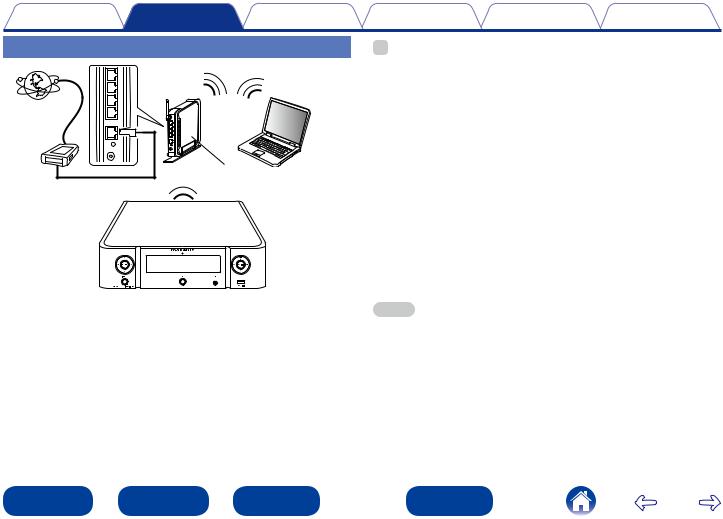
Contents |
Connections |
Playback |
Settings |
Tips |
Appendix |
Wireless LAN
Internet |
Modem |
To WAN side
PC
Router with  access point
access point
zz This unit comes with a built-in Wi-Fi antenna.
%
•With this unit, it is possible to use the DHCP and Auto IP functions to make the network settings automatically.
•When using this unit with the broadband router’s DHCP function enabled, this unit automatically performs the IP address setting and other settings.
When using this unit connected to a network with no DHCP function, make the settings for the IP address, etc., at “Network” (vpage 74).
•When using this unit, we recommend you use a router equipped with the following functions:
•Built-in DHCP server
This function automatically assigns IP addresses on the LAN.
•Built-in 100BASE-TX switch
When connecting multiple devices, we recommend a switching hub with a speed of 100 Mbps or greater.
•Use only a shielded STP or ScTP LAN cable which is easily available at electronics stores (CAT-5 or greater recommended).
•The normal shielded-type LAN cable is recommended. If a flat-type cable or unshielded-type cable is used, other devices could be affected by noise.
•When using a WPS (Wi-Fi Protected Setup) compatible router, easy wireless connection is possible by pressing this unit’s Wi-Fi CONNECT button. (See the separate “Quick Setup Guide”.)
NOTE
•The types of routers that can be used depend on the ISP. Contact your ISP or a computer shop for details.
•This unit is not compatible with PPPoE. A PPPoE-compatible router is required if you have a contract for a type of line set by PPPoE.
•Do not connect an NETWORK connector directly to the LAN port/ Ethernet connector on your computer.
|
|
|
|
|
|
|
|
22 |
|
|
Front panel |
|
|
Rear panel |
|
|
Remote |
|
Index |
|
|
|
|
|
|
|
|
|
|
|
|
|
|
|
|
|
|
|
|
|
|
|
|
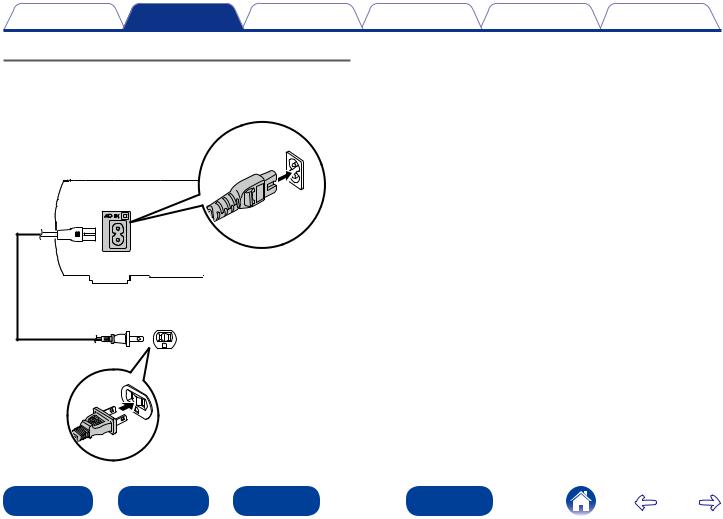
Contents |
Connections |
Playback |
Settings |
Tips |
Appendix |
Connecting the power cord
After completing all the connections, insert the power plug into the power outlet.
Power cord |
|
(supplied) |
To household power outlet |
|
(AC 120 V, 60 Hz) |
|
|
|
|
|
|
|
|
23 |
|
|
Front panel |
|
|
Rear panel |
|
|
Remote |
|
Index |
|
|
|
|
|
|
|
|
|
|
|
|
|
|
|
|
|
|
|
|
|
|
|
|
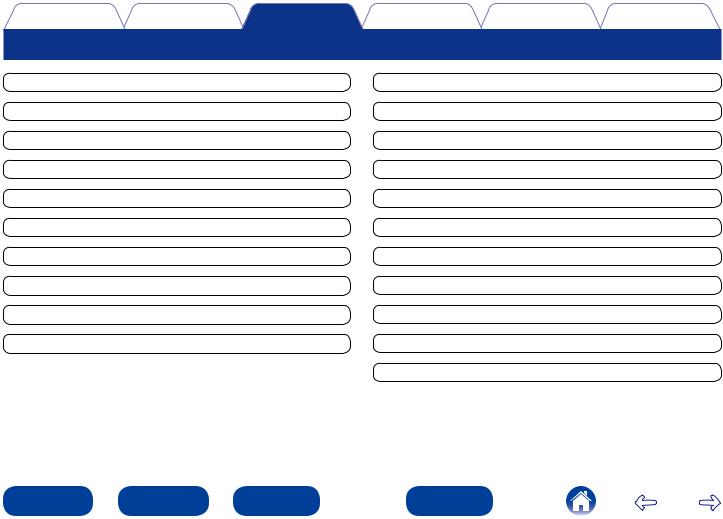
Contents |
Connections |
Playback |
Settings |
Tips |
Appendix |
Playback
Turning the power on (vpage 25)
Selecting the input source (vpage 25)
Adjusting the master volume (vpage 26)
Turning off the sound temporarily (vpage 26)
Listening to Internet Radio (vpage 27)
Playing back files stored on a PC and NAS (vpage 30)
Listening to Pandora® (vpage 34)
Listening to SiriusXM Internet Radio (vpage 38)
Listening to Spotify (vpage 40)
Favorite function (vpage 43)
Playing iPod (vpage 45)
Playing a USB memory device (vpage 49)
Listening to ANALOG IN (vpage 51)
Listening to DIGITAL IN (vpage 51)
AirPlay function (vpage 52)
Remote play function (vpage 55)
Web control function (vpage 57)
Adjusting the tone (vpage 63)
Sleep timer function (vpage 64)
Checking the current time (vpage 64)
Switching the display’s brightness (vpage 64)
|
|
|
|
|
|
|
|
24 |
|
|
Front panel |
|
|
Rear panel |
|
|
Remote |
|
Index |
|
|
|
|
|
|
|
|
|
|
|
|
|
|
|
|
|
|
|
|
|
|
|
|
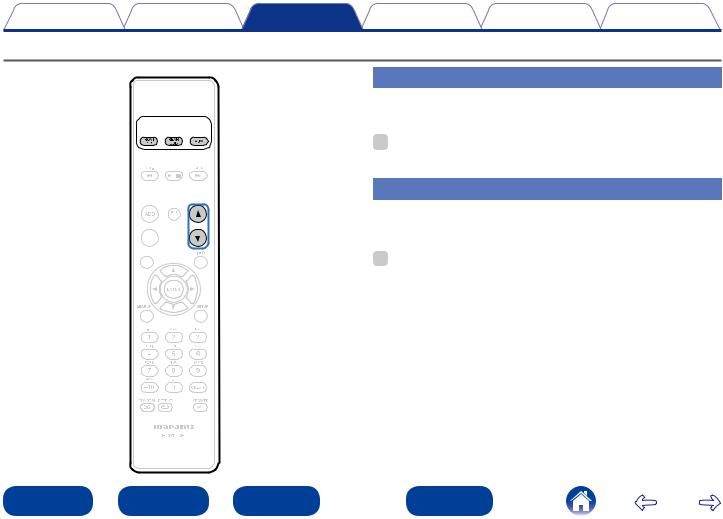
Contents |
Connections |
Playback |
Settings |
Tips |
Appendix |
Basic operation







 POWER X
POWER X
Input source 

 select buttons
select buttons 









 VOLUME df
VOLUME df
MUTE 







Turning the power on
1 Press POWER X to turn on power to the unit.
%
• You can also switch the power to standby by pressing X on the main unit.
Selecting the input source
1 |
Press the input source select button to be played back. |
The desired input source can be selected directly. |
%
•Press the AUX again to switch between Analog In / Digital In.
•You can also select the input source by pressing INPUT on the main unit.
|
|
|
|
|
|
|
|
25 |
|
|
Front panel |
|
|
Rear panel |
|
|
Remote |
|
Index |
|
|
|
|
|
|
|
|
|
|
|
|
|
|
|
|
|
|
|
|
|
|
|
|
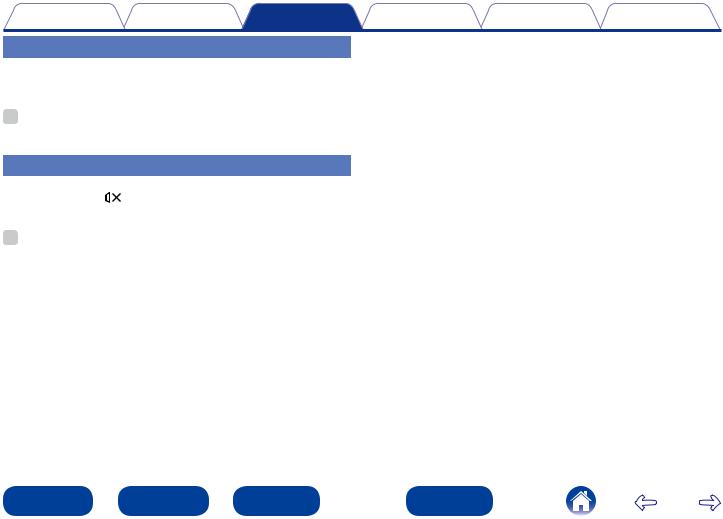
|
Contents |
Connections |
Playback |
Settings |
Tips |
Appendix |
Adjusting the master volume |
|
|
|
|
||
1 |
Use VOLUME df to adjust the volume. |
|
|
|
|
|
The volume level is displayed. |
|
|
|
|
||
%
• You can also adjust the master volume by turning VOLUME df on the main unit.
Turning off the sound temporarily
1 |
Press MUTE |
|
. |
|
|||
|
|||
|
The “MUTING” is displayed. |
||
%
• To cancel, press MUTE 
 again.
again.
|
|
|
|
|
|
|
|
26 |
|
|
Front panel |
|
|
Rear panel |
|
|
Remote |
|
Index |
|
|
|
|
|
|
|
|
|
|
|
|
|
|
|
|
|
|
|
|
|
|
|
|
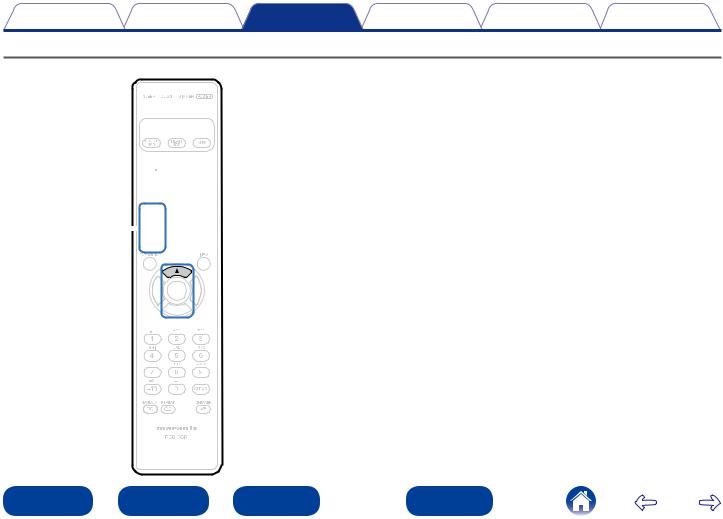
Contents |
Connections |
Playback |
Settings |
Tips |
Appendix |
Listening to Internet Radio
INTERNET 


 RADIO
RADIO 





1/3 




FAVORITES 

 ADD/CALL
ADD/CALL 



ui
ENTER 


SEARCH 




•Internet Radio refers to radio broadcasts distributed over the Internet. Internet Radio stations from around the world can be received.
•The broad cast station types and specifications supported by this unit for playback are as follows.
•WMA (Windows Media Audio)
•MP3 (MPEG-1 Audio Layer-3)
•MPEG-4 AAC
|
|
|
|
|
|
|
|
27 |
|
|
Front panel |
|
|
Rear panel |
|
|
Remote |
|
Index |
|
|
|
|
|
|
|
|
|
|
|
|
|
|
|
|
|
|
|
|
|
|
|
|
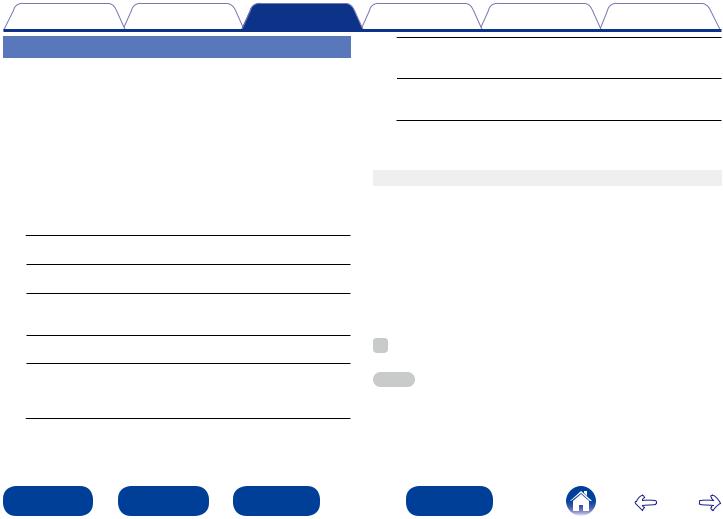
Contents |
Connections |
Playback |
Settings |
Tips |
Appendix |
Listening to Internet Radio
This unit memorizes the last played Internet Radio station. If you press INTERNET RADIO to switch to the Internet Radio function from another input source, the last Internet Radio station you listened to is played.
1 |
Prepare for playback. |
•Check the network environment, then turn on this unit’s power |
|
|
(vpage 21 “Connecting to a home network (LAN)”). |
2 |
Press INTERNET RADIO. |
3 |
Use ui to select the you want to play, then press |
ENTER. |
zzzzz (Country name) :
•Displays typical Internet Radio stations your country.
Search Stations :
•Displays all Internet Radio stations that this unit can tune in to.
Search Podcasts :
•Displays Internet Radio stations in the podcasts that this unit can tune in to.
Recently Played :
•Displays recently played Internet Radio stations. Up to 20 stations can be stored in “Recently Played”.
Search by Keyword :
•Displays Internet Radio stations searched by keyword. For character input, see page 68.
4 |
Use ui to select the station, then press ENTER. |
||
Playback starts once buffering reaches “100%”. |
|||
|
|
||
Operation buttons |
Function |
||
1/3 |
Playback / Stop |
||
FAVORITES CALL |
Call from the Favorite list |
||
FAVORITES ADD |
Registration to the Favorite list |
||
|
|
Character search |
|
SEARCH |
•If the list is not in alphabetical order, you |
||
may not be able to perform a character |
|||
|
|
||
|
|
search. |
|
INTERNET RADIO |
Last played Internet Radio station |
||
INFO |
Switching the file type/ bit rate and radio |
||
station name etc. display |
|||
|
|
||
Recommended Stations :
•Displays recommended Internet Radio stations. radiomarantz.com :
•Displays Internet Radio stations added to favorites in vTuner. For instructions on how to add to favorites in vTuner, see “Using vTuner to add Internet Radio stations to favorites” (vpage 29).
%
•Any characters that cannot be displayed are replaced with “.” (period).
NOTE
•The radio station database service may be suspended or be otherwise unavailable without notice.
|
|
|
|
|
|
|
|
28 |
|
|
Front panel |
|
|
Rear panel |
|
|
Remote |
|
Index |
|
|
|
|
|
|
|
|
|
|
|
|
|
|
|
|
|
|
|
|
|
|
|
|
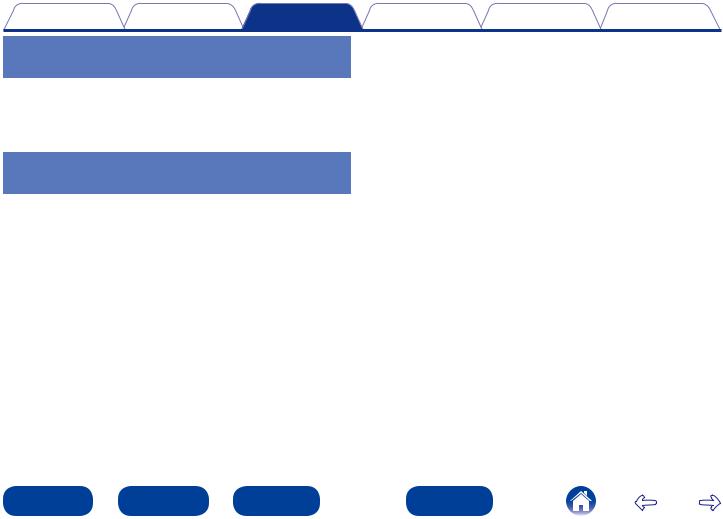
Contents |
Connections |
Playback |
Settings |
Tips |
Appendix |
Playing the last played Internet Radio station
1 |
Press INTERNET RADIO. |
The source switches to “Internet Radio” and the last played radio |
station plays.
Using vTuner to add Internet Radio stations to favorites
There are many Internet Radio stations in the world, and this unit can tune into these stations. But finding the radio station you want to hear may be difficult, because there are too many stations. If this is the case, then please use vTuner, an Internet Radio station search website specifically designed for this unit. You can use your PC to search Internet Radio stations and add them as your favorites. This unit can play radio stations added to vTuner.
1 Check the MAC address of this unit (vpage 74
“Network Information”).
•The MAC address is necessary when you create an account for vTuner.
2 |
Use your PC to access the vTuner website (http://www. |
radiomarantz.com). |
3 |
Enter the MAC address of this unit, then click “Go”. |
4 |
Enter your E-mail address and a password of your |
choice. |
|
5 |
Select the search criteria (genre, region, language, etc.) |
of your choice. |
|
|
•You can also enter a keyword to search for a station you want to |
|
hear. |
6 |
Select the radio station of your choice from the list, and |
then click the Add to Favorites icon. |
|
7 |
Enter the name of the favorite group, then click “Go”. |
A new favorite group that includes the selected radio station is |
created.
•Internet Radio stations added to favorites in vTuner can be played from “radiomarantz.com” (vpage 28) with this unit.
22Files that can be played back
See “Playing back Internet Radio” (vpage 91).
|
|
|
|
|
|
|
|
29 |
|
|
Front panel |
|
|
Rear panel |
|
|
Remote |
|
Index |
|
|
|
|
|
|
|
|
|
|
|
|
|
|
|
|
|
|
|
|
|
|
|
|
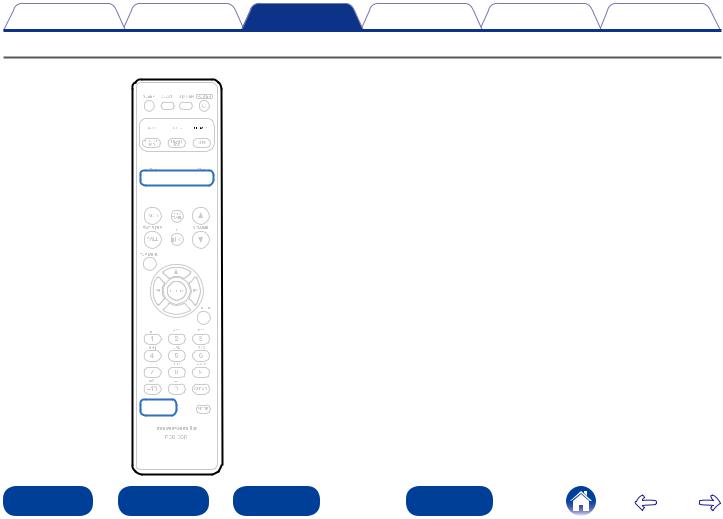
Contents |
Connections |
Playback |
Settings |
Tips |
Appendix |
Playing back files stored on a PC and NAS



 MUSIC
MUSIC
SERVER
1/3
89




 INFO
INFO
SEARCH 



RANDOM
REPEAT 




•This unit can play back music files and playlists (m3u, wpl) stored on a PC and on Network Attached Storage (NAS) that supports DLNA.
•The network audio playback function of this unit connects to the server using technologies shown below.
•Windows Media Player Network Sharing Service
•Windows Media DRM10
•This unit can play back the following files.
•WMA (Windows Media Audio)
•MP3 (MPEG-1 Audio Layer-3)
•WAV
•MPEG-4 AAC
•FLAC (Free Lossless Audio Codec)
•ALAC (Apple Lossless Audio Codec)
|
|
|
|
|
|
|
|
30 |
|
|
Front panel |
|
|
Rear panel |
|
|
Remote |
|
Index |
|
|
|
|
|
|
|
|
|
|
|
|
|
|
|
|
|
|
|
|
|
|
|
|
